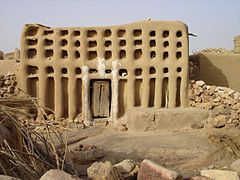Hogon

A Hogon is a spiritual leader in a Dogon village.
Dogon people
The Dogon are an ethnic group in Mali, with some unusual mythology and cultural practices. Most Dogon villages are situated around the arid Bandiagara Escarpment in central Mali.
The life of a hogon

A hogon is a religious figure as well as a temporal authority;[1] the hogon may be hereditary or may be chosen from among the village elders—custom varies from place to place. The hogon is always a man. After being chosen, a hogon must pass through several months without washing or shaving. After initiation, he wears a red cap, and a pearl bracelet. Hogon live alone and should be celibate, but a village girl may act as a maid. Nobody should touch the hogon.[2]
It has become customary for tourists to bring small gifts of money or kola nuts for the hogon when visiting a village.[3]
Ritual

The Hogon has a key role in village rituals and in ensuring fertility[4] and germination.[5]
The Hogon is central to a wide range of fertility and marriage rituals, which are closely related to Dogon origin myths.[6]
The Hogon may conduct rituals in the Sanctuaire de Binou, a special building whose door is blocked with rocks.[7]
Creation myth
According to legend, the first hogon, Lebe, was descended from a nommo. He was eaten by another nommo, and their spirits merged; the nommo vomited out a new Lebe (part human and part spiritual), plus copious liquid which shaped the landscape.[8][9]
See also
References
- ^ Imperato, Pascal James (1978). Dogon cliff dwellers: the art of Mali's mountain people. L. Kahan Gallery/African Art. p. 12.
- ^ Velton, Ross (2009). Mali. Bradt Travel Guides. p. 195. ISBN 978-1-84162-218-7.
- ^ Velton, Ross (2009). Mali. Bradt Travel Guides. p. 204. ISBN 978-1-84162-218-7.
- ^ Bonnefoy, Yves (1993). American, African, and Old European mythologies. University of Chicago Press. p. 123. ISBN 978-0-226-06457-4.
- ^ Heusch, Luc de (June 1997). "Les mécanismes symboliques de la royauté sacre: à la re-découverte de Frazer". Journal of the Royal Anthropological Institute (2).
{{cite journal}}:|access-date=requires|url=(help) - ^ Dieterlen (1956). "Parenté et Mariage Chez les Dogon". Africa. 26 (2): 107–148. doi:10.2307/1156839.
- ^ The rough guide to West Africa. Rough Guides. 2003. p. 391. ISBN 978-1-84353-118-0.
- ^ "Dogon". Retrieved 26 March 2011.
- ^ Imperato, Pascal James (2001). Legends, sorcerers, and enchanted lizards: door locks of the Bamana of Mali. Africana Publishing. ISBN 978-0-8419-1414-8.
